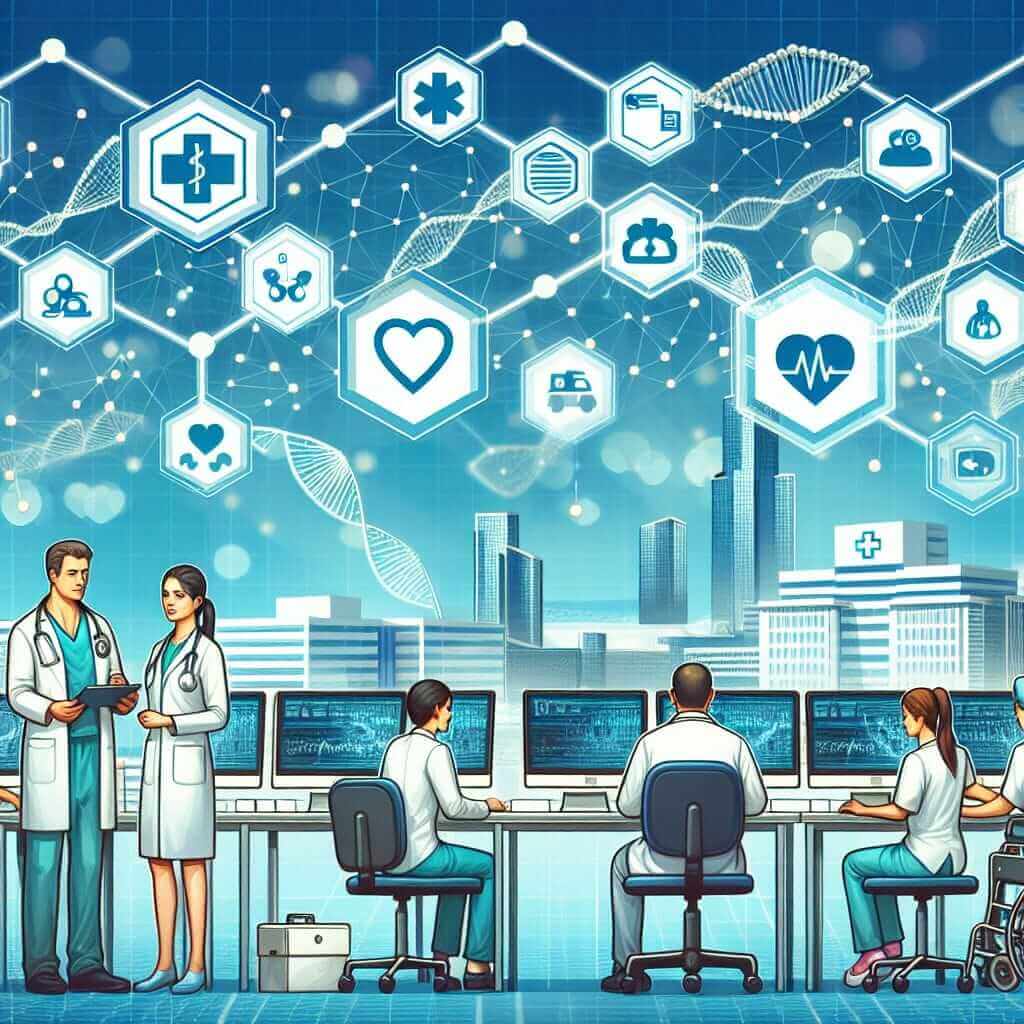The IELTS Reading test assesses a wide range of reading skills, including how well you read for the gist, main ideas, detail, and understanding inferences. In recent years, topics on emerging technologies such as blockchain in healthcare have been increasingly frequent. This is due to their current relevance and transformative potential. Given the rising frequency of such themes, it is prudent to be well-prepared for similar topics in future exams.
Practice Reading Passage and Questions
Reading Passage: How is Blockchain Being Used in Healthcare?
Blockchain technology, originally devised for the digital currency Bitcoin, is revolutionizing various industries, with healthcare being a prime example. Blockchain’s potential in healthcare lies in its ability to enable secure, precise, and immutable record-keeping. By providing a decentralized ledger, blockchain can increase transparency and accessibility while ensuring data integrity and security.
One significant application of blockchain in healthcare is in patient data management. Traditional systems often struggle with data interoperability and security. Blockchain addresses these issues by providing a unified and secure platform for sharing patient information among various healthcare providers without compromising privacy. Each patient’s medical history can be securely stored and accessed, mitigating the risks of data breaches and fraud.
Additionally, blockchain is being utilized for drug traceability. The pharmaceutical supply chain is plagued by counterfeits and inefficiencies. Blockchain solutions can track drugs from manufacturer to patient, ensuring authenticity and safety. By creating a transparent and auditable supply chain, blockchain can prevent counterfeit medicines’ infiltration into the market, thus safeguarding public health.
Blockchain also offers promise in clinical trials and research. Ensuring the integrity and verification of data in clinical trials is crucial. Blockchain can provide a tamper-proof system where data from trials are securely recorded and can be easily verified and audited. This can accelerate research, enhance data reliability, and foster trust among stakeholders.
Furthermore, blockchain technology is being explored for insurance claims processing. This application aims to streamline and automate the claims process, reduce errors, and prevent fraud. By using smart contracts—self-executing contracts with the terms directly written into code—the insurance industry can ensure timely and accurate processing of claims.
In conclusion, blockchain’s applications in healthcare are diverse and transformative. From securing patient data to verifying drug authenticity and optimizing clinical trials, blockchain is set to become an indispensable tool in the healthcare industry. As blockchain technology continues to evolve, its implementation in healthcare will undeniably expand, offering substantial benefits to patients, providers, and stakeholders alike.
Questions
Multiple Choice
-
What is a primary benefit of blockchain technology in healthcare?
a) Increasing administrative tasks
b) Enhancing data security and interoperability
c) Reducing medical research
d) Decreasing accessibility of patient records -
How does blockchain help in drug traceability?
a) By allowing anonymous purchase of medicines
b) Through creating a transparent drug supply chain
c) By limiting the production of pharmaceuticals
d) Due to restricting access to pharmaceutical data
True/False/Not Given
- Blockchain can completely prevent any form of data breaches in healthcare.
- Smart contracts are used in healthcare primarily for patient registration processes.
- Blockchain technology has already completely taken over the insurance claims processing in all healthcare institutions.
Matching Information
Match the following applications of blockchain with their descriptions:
a) Patient Data Management
b) Drug Traceability
c) Clinical Trials
d) Insurance Claims Processing
- Ensuring integrity and verification of trial data
- Increasing privacy and security in sharing patient information
- Creating a tamper-proof supply chain
- Automating and reducing errors in claims processing
Answers with Explanations
-
b) Enhancing data security and interoperability
Explanation: Blockchain’s decentralized ledger improves data security and enables the secure sharing of patient information. -
b) Through creating a transparent drug supply chain
Explanation: Blockchain can track drugs throughout the supply chain, ensuring authenticity and preventing counterfeits. -
False
Explanation: While blockchain significantly increases data security, it cannot fully prevent data breaches. -
Not Given
Explanation: The passage does not provide information specifically linking smart contracts to patient registration processes. -
False
Explanation: The implementation of blockchain for insurance claims processing is still evolving and not yet widespread in all institutions. -
c) Clinical Trials
Explanation: Blockchain ensures data integrity and verifiability in clinical trials. -
a) Patient Data Management
Explanation: Blockchain provides a secure and private platform for sharing patient data. -
b) Drug Traceability
Explanation: Blockchain tracks drugs to ensure a safe and transparent supply chain. -
d) Insurance Claims Processing
Explanation: Smart contracts automate claims processing, reducing errors and fraud.
Common Mistakes
When tackling reading passages with a complex topic like blockchain, students often fall into these traps:
- Misinterpreting technical terms due to insufficient background knowledge.
- Overlooking key details that differ between similar options in multiple-choice questions.
- Assuming unstated facts in True/False/Not Given questions.
Vocabulary
- Blockchain (n) /ˈblɒkˌʧeɪn/: A digital ledger system for recording transactions securely and transparently.
- Interoperability (n) /ˌɪntəˌɒpərəˈbɪlɪti/: The ability for different systems to work together and exchange information.
- Counterfeit (adj) /ˈkaʊntəfɪt/: Made in imitation of something else with intent to deceive.
- Tamper-proof (adj) /ˈtæmpərˌpruːf/: Designed to be impossible to alter or manipulate.
Grammar Point
Passive Voice in Describe Processes:
- Used to emphasize the action or process rather than the subject.
- Structure: [Subject] + [Be] + [Past Participle]
Example: “Data from clinical trials are securely recorded.”
Tips for High IELTS Reading Scores
- Skimming and Scanning: Quickly skim passages to get the gist before diving into detailed questions. Scan for keywords related to the questions.
- Understanding Keywords: Identify and understand key terms that frequently appear in passages and questions, especially technical or scientific terms.
- Practice Regularly: Make regular practice a habit, using articles on current technology trends like blockchain.

Remember, consistent practice and familiarization with a wide range of topics will build your confidence for the IELTS Reading test. Happy studying!